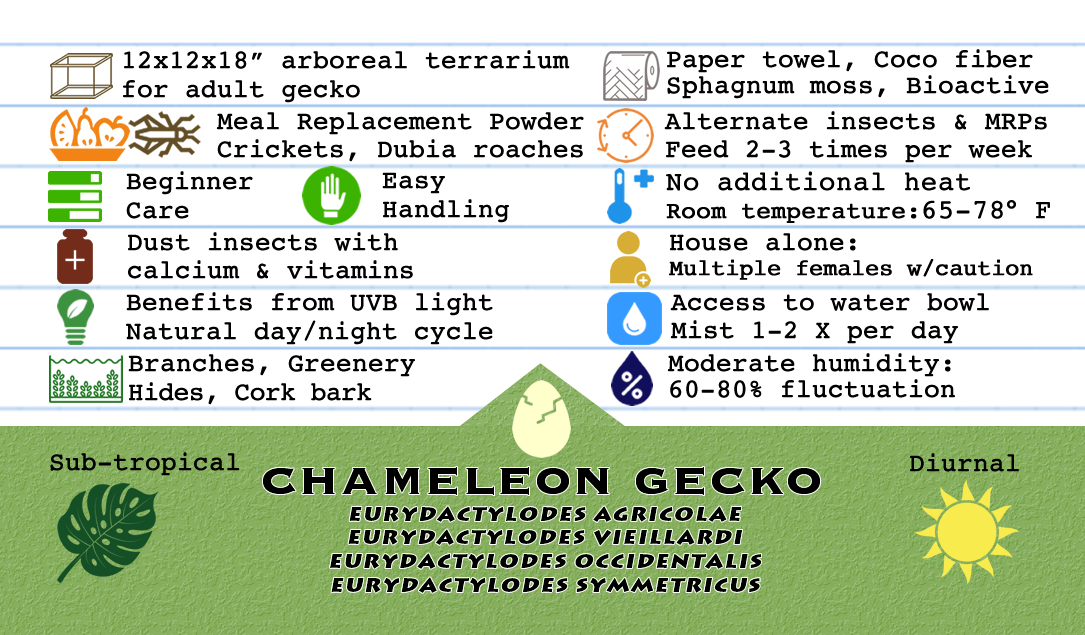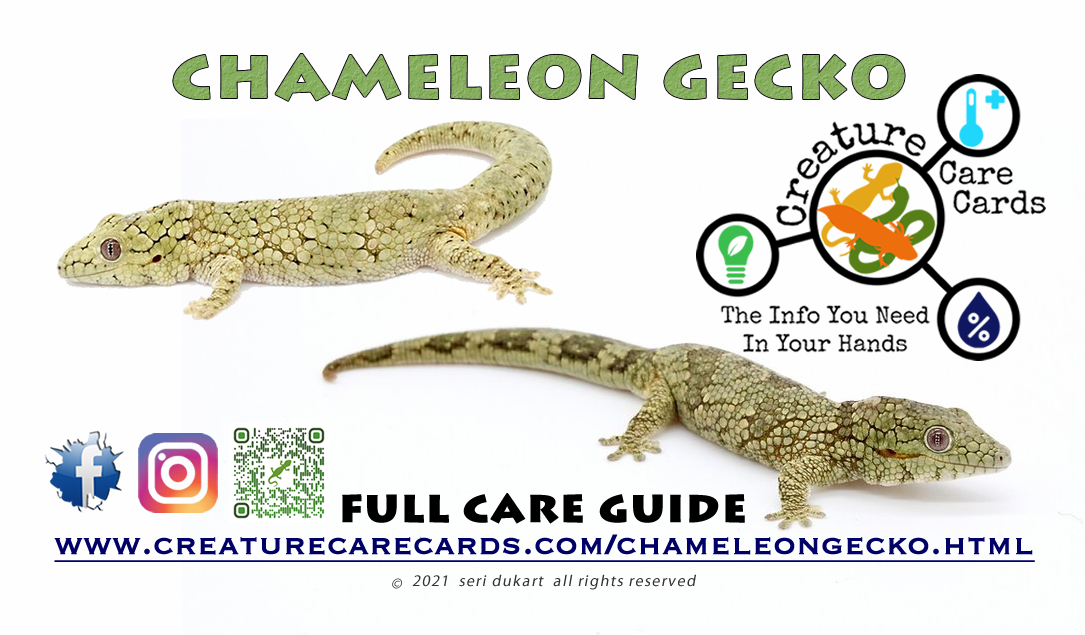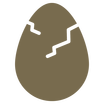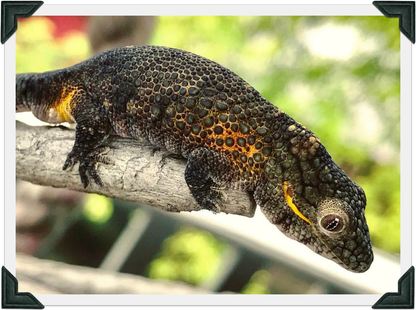Eurydactylodes agricolae and vieillardi - Bauer's and Vieillard’s Chameleon Geckos
Chameleon Geckos (E. agricolae and E. vieillardi) are a small, robust slow moving gecko. They are a sub-tropical, arboreal gecko and are diurnal. They are very similar in looks and care, with one being more commonly available in the hobby. There are also two other much lesser seen species, E. occidentalis and E. symmetricus.
|
Bringing Your New Pet Home
When you bring your new gecko home, you should already have a quarantine tank set up and ready to go. Place fresh water in a bowl in the tank, mist the tank and offer food, but be aware it is completely normal for them to refuse food for the first couple days, or even longer. You should keep this new gecko separate from any other geckos you may have for 90 days, to ensure there is nothing it could spread to your other animals. Monitor its eating and fecals as they may be strange for up to a couple weeks, but this is due to a new diet, supplements, and environment. It is recommended you do not handle your new gecko for the first 24-48 hours and keeping it to a minimum until it has started eating on its own. Always keep in mind, your new animal is in a new tank, with new decor/dishes/hides, and new faces watching them. They need time to become acclimated to it all. After this quarantine process, they can be safely introduced to their permanent enclosure if it's not already. Be sure to wash your hands before handling any other geckos during this time. |
|
Substrate
Chameleon geckos thrive best on simple substrates such as paper towel, sphagnum moss, or eco-earth. Loose substrates should be used with caution; geckos can ingest it while hunting bugs and become impacted. If you use loose substrates, it is best to feed out of enclosure or by tongs. Female chameleon geckos will lay eggs when they reach breeding age, even if they were never with a male. It is best to provide all female geckos with a lay box with loose substrate for them to lay their eggs and prevent egg binding. |
|
Compatibility
Geckos by nature are solitary animals. In chameleon geckos, females can be housed together with caution. They must be of the same size to prevent bullying. If you do choose to house more than one gecko together, more space is needed, with an additional 5 gallons of space per additional gecko. Adding more hides and decor will help prevent fighting. Males will fight with one another, and geckos of different sizes will bully and attack one another. Do not house males and females together unless you have researched breeding and are prepared for eggs and babies. Monitor females to be sure they are not picking on one another or one is not hoarding the food from the other. |
|
Temperatures
Chameleon geckos come from New Caledonia, where temperatures rarely reach over 80 degrees F. However, they have a higher heat tolerance than crested geckos and thrive in slightly higher temperatures. A low wattage basking spot is appreciated. Monitor temperatures to be sure they stay between 78-82 degrees with a basking spot in the lower 80s'.Do not exceed basking temperatures of 82 degrees F. |
|
Lighting
Chameleon geckos are diurnal, meaning they are active in the daytime. They should be exposed to 10-12 hours of light per day. They benefit from tropical UVB lighting and it is highly recommended. All lights should be placed on a timer. 
We recommend VivTech Sursun LED bulbs! |
|
Cage Decor
Since they are arboreal, they need to have places to hide to sleep and climb. You will most often find chameleon geckos hanging out in branches or foliage, so decorate the tank heavily with fake greenery, branches, with the addition of cork bark and cork rounds. |
|
Humidity and Shedding
Chameleon geckos are a sub-tropical species, so they require moderate humidity level of around 60-80% with dry periods. You can best achieve this by misting the enclosure twice a day, once in the morning and once at night. While it is good to offer a shallow bowl of fresh water, most geckos will not drink from bowls and instead prefer to lick water droplets off the enclosure walls and plants. Misting will not only keep the humidity levels up, but offer them hydration as well. You do not want the cage soaking wet, and should allow it to dry out some between mistings. Chameleon geckos will shed their skin as they grow and regularly as adults. You’ll notice their color will appear dull when they are about to shed. Generally, the gecko will eat all of their shed, but you may see some of the shed skin in the cage. Some geckos will have unshed skin on their toes, we suggest letting your gecko soak in a shallow container of lukewarm water for a few minutes and you can assist the process by gently removing the skin using tweezers. Stuck shed is often an indication of humidity issues, so you can help this by misting more often or heavier.
|
|
Water
Your chameleon gecko should have access to fresh, clean water in a shallow bowl at all times. Some will not drink directly from bowls and prefer to lick water from misting off leaves, but many have been seen drinking from bowls. Water can be treated with a commercial water treatment to remove any harsh chemicals from the water. |
|
Feeding Chameleon geckos are insectivores and frugivores. Typically, their diet consists of small insects like fruit flies,crickets or dubia roaches and a commercial based, balanced fruit powder you prepare much like a smoothie. These diets are called meal replacement powders or MRPs. Do not feed mealworms or superworms, as they do not digest them well. Crickets can be placed in the enclosure during feeding time, but uneaten crickets should always be removed. MRPs can be mixed in small bowls and placed in enclosure. Insects should be gutloaded with a commercial gutload product. Gutloading refers to the practice of feeding the insects a nutritious diet before offering them to your gecko, to ensure the most balanced nutrition. Geckos that are under 4-6 months old should have MRPs available at all times and it should be changed out every other day with fresh food. Adults can go a few days between feedings and should be offered fresh food 2+ times per week. Keep on eye on food to be sure it is not molding, and remove or replace if it is. Crickets or roaches can be offered 2-3 times a week. Be sure the insect is appropriately sized for your gecko. It should be no larger than the space between their eyes. Uneaten insects should be removed after a few hours. 
There are many MRPs on the market in a variety of flavors. Some of the most commonly found are Pangea Complete Gecko Diet and Repashy Gecko Diet. |
|
Handling
Chameleon geckos are usually open to being handled and with regular contact, can become very tame. Sit on the floor and let your gecko walk from hand to hand at their own pace. While their tails will grow back if harmed, this species does not drop their tails as a response to threat. They are a slow moving gecko that will cling to your fingers - they can actually be quite difficult to remove from your finger once they settle! When threatened or agitated, agricolae and vieillardi are capable of secreting a pungent smelling sticky substance from the caudal glands located in their tails. The secretions do not seem to irritate human skin but there are reports of it causing very intense irritation to the eyes. Geckos that are used to human interaction will not do this as long as care is taken not to startle them too much. |
|
Shopping List with links to tried and true products
|






























